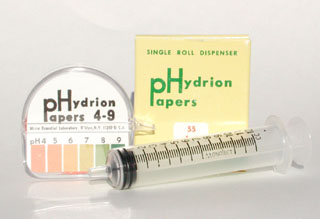
| pH strip test. |
Introduction:
Testing rumen pH involves obtaining a sample of rumen fluid and performing a simple test to determine how much acid or how much base is in the sample. The lower the pH of a substance, the more acidic the sample. Conversely, the higher the pH, the more basic the sample.Reasons to Perform the Test: Performing this test is important in situations such as grain overload (acidosis) and indigestion. With changes in pH, the normal bacteria and protozoa in the rumen change and even die off. The overgrowth and death of certain bugs can cause an animal to go off feed and show signs of indigestion. Determining the rumen pH is essential in diagnosing grain overload, since the normal rumen pH should be greater than 5.5 and preferably around 6 to 6.5. Any rumen sample with a pH level of less than 5.5 indicates an acidosis problem and appropriate treatment should begin.
Ways to Obtain a Sample for pH Testing:
Flock/Herd-wide Signs of Disease that may Indicate an Underlying Acidosis Problem:
 |
|